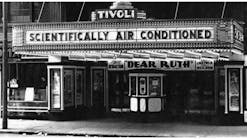The Data Revolution: How Information Technology Is Transforming Buildings and HVACR
Demand for improved performance is constant and drives action across the economy. The key to improved performance is data, and the key to data is measurement. Recent dramatic advances in data acquisition and online processing are revolutionizing possibilities for improved performance throughout industry and will transform demands on the HVACR community for continual improvement of its technology, products, and services.
The impact of data on HVACR already is visible. Data centers are a leading “special needs” customer. A demand-response, smart-grid interface is an increasing influence on product design. Environmental monitoring is driving all life-cycle aspects of HVACR equipment, increasing the demand for precision and performance.
These well-known events, however, are just the early tremors of a tectonic shift. Because of the tremendous possibilities arising from innovations in data acquisition and processing, desires for remote monitoring and control are becoming real opportunities. Equipment can be micromonitored, adjusted, and diagnosed from distant locations. Utilities can manage sophisticated demand-response programs and incentivize targeted power-consumption profiles. Building loads and equipment performance can be measured closely on an end-use (lighting, heating, cooling, ventilation, plug load) basis.
What “big data” means for HVACR and the built environment is easier to see when big data is viewed in the broader context of the revolution it is driving across the economy.
Data on Data
“Big data,” Financial Times notes, “does not just mean a lot of information. It also refers to so-called unstructured data—sensor data, social-media outpourings, video, and images—that do not fit neatly into the rows and columns of most databases.”1
Those data are being put to work. According to Financial Times, 33 percent of companies surveyed are using data analytics “across the entire enterprise,” and two-thirds had appointed a senior executive to oversee data management within the previous 18 months.1
“Companies will compete on the consumption of analytics,” Financial Times concluded.1
Citing McKinsey Global Institute research, Financial Times says, “Big data could provide a 50-percent decrease in product-development and assembly costs in manufacturing,” and a dramatic jump in retailers’ operating margins. Across industry, the message is the same: “Data and data analysis are widely regarded as the next frontier for business productivity and competition.”1
Buildings, Data, and Equipment Value
Building information modeling (BIM) makes possible information-based digital representations of buildings, including their physical characteristics, operation, and expected performance throughout their life. BIM is stored knowledge, the life of a building in data.
Data on every facet of a building from construction through demolition can be collected, analyzed, and stored as a shared-knowledge resource designers can tap to make informed decisions. The result is an industry move toward data-based predictability of building envelope, building systems, temperature profile, power use, carbon footprint, and more. For HVACR manufacturers, the result is greater certainty in terms of the value they offer.
Manufacturers of HVACR equipment long have struggled with the challenge of “first cost.” How do they sell high-efficiency equipment that will lower energy costs in the years ahead, but costs more upfront? The problem has stemmed from the reluctance of developers and building owners to invest in more-efficient equipment for fear they cannot return the investment to the bottom line. That reluctance has been rooted deeply in an uncertainty about whether passive building-design characteristics and active, dynamic load-meeting equipment will perform as a system and produce promised energy-utilization reductions and improved indoor environments.
With BIM and relatively inexpensive monitoring, data processing, and information-transfer technology, building and system performance can be assessed in advance using data and information accumulated across a broad spectrum, lodged in a permanent database, and accessed by a skilled sales force or a knowledgeable design team. Performance can be predicted with certainty and bottom-line implications known while a building is on the drawing board. With this capability, however, emerges a new set of challenges to be addressed: the need for equipment to interface with a system of ongoing data collection and analysis and archived data and knowledge and meet the requirement of transparency in interaction processes. Moving forward, the HVACR community faces the demands of a disciplined, data-based, continuous-feedback-loop milieu not unlike that in transportation- and manufacturing-industry systems.
Efficient Construction
The new building model tightly links design, construction, and operations, as their respective teams tap the same data and information resources. At the same time, the building-delivery process is driven toward collaboration by investors wanting to optimize return on capital through knowledge-based design and construction.
New-building construction is responsible for about 7 percent of America’s gross domestic product, according to University of Massachusetts Amherst’s Department of Environmental Conservation.2 As a result, more automation-based strategies and principles are being applied to maximize construction efficiency. From the selection of materials to the sequencing of construction to indoor-environment performance, a building project can be mapped in advance for maximum efficiency and performance with data-management tools. Builders with growing margin pressures are looking for that efficiency, and, at the heart of it, data make it possible.
In the built environment, competitiveness depends on more than equipment performance and price. Other factors include size, shape, and availability and how they fit into the overall construction plan. More broadly, an equipment provider may need to work alongside and with the architect and other system providers from project conception to optimize a range of value criteria, such as performance, installation efficiency, and future replacement. This is the integrated design and delivery process, to which data and information exchange among team members is critical.
Software companies are introducing products that simulate building performance by the hour, calculating even such variables as external shading. For example, simulation can show the positioning of a building may make solar panels the most practical option and simultaneously reduce building power load. Rainfall data, meanwhile, can be factored into assumptions about a building’s water and wastewater use. The effects of these variables on construction costs can be studied in alternative configurations and calculated in rapid succession, making knowledge-based decisions in real time possible—all because of data.
Precision in Building Automation
Building management is becoming substantially more data-driven as well. Integrated controls and Web-based monitoring offer precision in building management that outstrips past experience. Today’s controls mimic intelligent minicomputers that collect data from all of a building’s systems, including envelope and end-use subsystems (e.g., lighting, heating, cooling, occupant-driven information technology, air handling, water, security).
Equipment, then, can be part of constantly evaluated system performance. In June 2013, HPAC Engineering reported: “After years of steady but low growth, the commercial building-automation-systems (BAS) market is experiencing a rapid period of change and investment, according to ABI Research. ABI forecasts that by 2018, the building-automation-services market will grow to $43 billion, up from $35 billion in 2013.”3
New Vision, New Challenges
The HVACR world will be dominated by a new vision, one seeing data facilitating measurement, management, performance, and continuous design improvement. HVACR equipment and other building systems will need to be designed to both provide and respond to data. The potential for such a transformation creates an industry full of uncertainties and challenges.
The first question concerns whether the labor force required for advanced building management is available. Indeed, the labor challenge is being felt across the big-data economy. Financial Times quoted John Harris, chairman of the Corporate IT Forum, saying, “A skills and personnel gap is the main stumbling block to realizing the business value of data.”4 Thus, education will be a major challenge facing HVACR and building-industry leaders.
The building industry also will be challenged to reach new levels of innovation to meet the demands of a data-driven world. The industry will need to draw on its history and experience to develop product and manufacturing cycles that respond to a new set of expectations brought on by the digital, data-driven integrated design and delivery process emerging in the industry. Further, it will need to influence customer perception and educate users and building owners on the value of these new, innovative technologies.
That the built environment is in the midst of a data-driven revolution is not in doubt. How the buildings industry should respond, however, is not so obvious. What is known is that it surely will test the best the HVACR industry has to offer.
References
1) The future of business data. (n.d.). Financial Times. Retrieved from http://databoard.ft.com/
2) Building and construction technology. (n.d.). Retrieved from http://eco.umass.edu/degree-programs/undergraduate-programs/building-and-construction-technology/
3) Rajecki, R. (2013, June 4). New entrants, connectivity, and investment driving rapid bas market growth. HPAC Engineering. Retrieved from https://www.hpac.com/building-automation/article/20927203/new-entrants-connectivity-and-investment-driving-rapid-bas-market-growth.
4) McKenna, B. (2013, January 15). Prospecting for corporate it gold. Financial Times. Retrieved from http://www.ft.com/intl/cms/s/2/e5f19c54-49cd-11e2-a7b1-00144feab49a.html#axzz331lCsMc2
Robert Cavey is a partner at Praxis, an organization working to achieve global sustainability through collaborative education and research. Previously, he served as president of Global Strategy Initiative, senior associate for the Carnegie Endowment for International Peace, and vice president of public and government affairs for American Standard Cos. Lisa Tryson is director of corporate communications and public relations for Danfoss North America, manufacturer of high-efficiency controls and components for HVAC and allied industries. Previously, she headed global marketing communications for the company’s Refrigeration & Air Conditioning division in Denmark. She leads Danfoss’ EnVisioneering thought-leadership program.
Did you find this article useful? Send comments and suggestions to Executive Editor Scott Arnold at [email protected].









